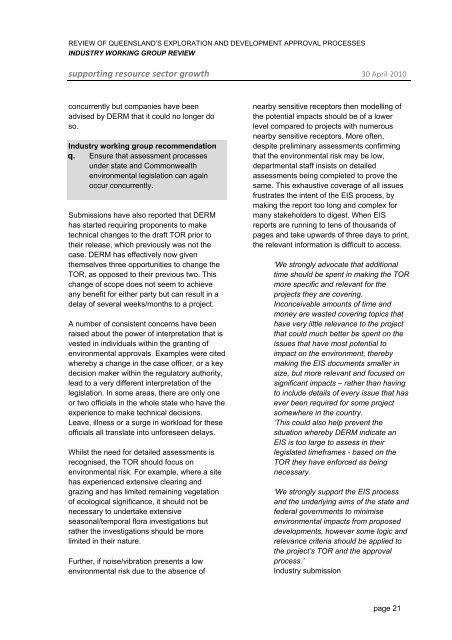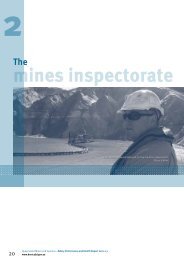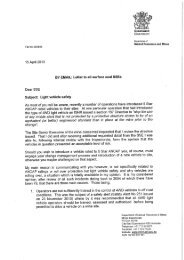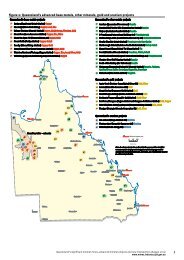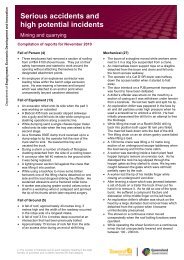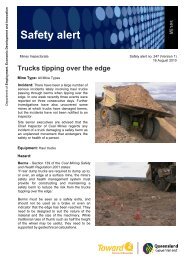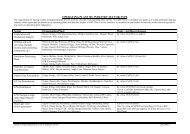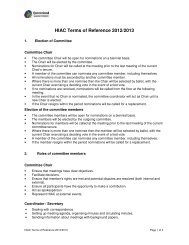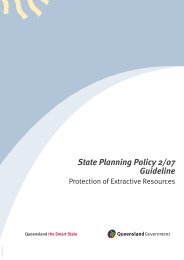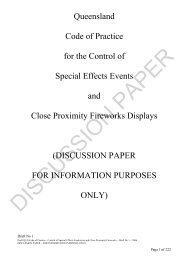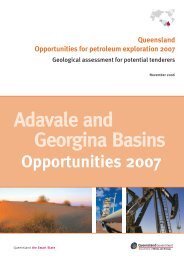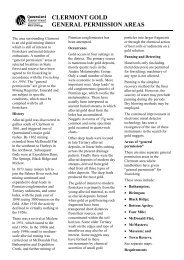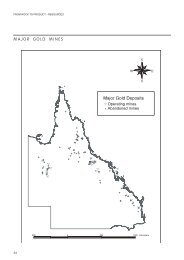supporting resource sector growth - Queensland Mining and Safety ...
supporting resource sector growth - Queensland Mining and Safety ...
supporting resource sector growth - Queensland Mining and Safety ...
You also want an ePaper? Increase the reach of your titles
YUMPU automatically turns print PDFs into web optimized ePapers that Google loves.
REVIEW OF QUEENSLAND’S EXPLORATION AND DEVELOPMENT APPROVAL PROCESSES<br />
INDUSTRY WORKING GROUP REVIEW<br />
<strong>supporting</strong> <strong>resource</strong> <strong>sector</strong> <strong>growth</strong> 30 April 2010<br />
concurrently but companies have been<br />
advised by DERM that it could no longer do<br />
so.<br />
Industry working group recommendation<br />
q. Ensure that assessment processes<br />
under state <strong>and</strong> Commonwealth<br />
environmental legislation can again<br />
occur concurrently.<br />
Submissions have also reported that DERM<br />
has started requiring proponents to make<br />
technical changes to the draft TOR prior to<br />
their release, which previously was not the<br />
case. DERM has effectively now given<br />
themselves three opportunities to change the<br />
TOR, as opposed to their previous two. This<br />
change of scope does not seem to achieve<br />
any benefit for either party but can result in a<br />
delay of several weeks/months to a project.<br />
A number of consistent concerns have been<br />
raised about the power of interpretation that is<br />
vested in individuals within the granting of<br />
environmental approvals. Examples were cited<br />
whereby a change in the case officer, or a key<br />
decision maker within the regulatory authority,<br />
lead to a very different interpretation of the<br />
legislation. In some areas, there are only one<br />
or two officials in the whole state who have the<br />
experience to make technical decisions.<br />
Leave, illness or a surge in workload for these<br />
officials all translate into unforeseen delays.<br />
Whilst the need for detailed assessments is<br />
recognised, the TOR should focus on<br />
environmental risk. For example, where a site<br />
has experienced extensive clearing <strong>and</strong><br />
grazing <strong>and</strong> has limited remaining vegetation<br />
of ecological significance, it should not be<br />
necessary to undertake extensive<br />
seasonal/temporal flora investigations but<br />
rather the investigations should be more<br />
limited in their nature.<br />
Further, if noise/vibration presents a low<br />
environmental risk due to the absence of<br />
nearby sensitive receptors then modelling of<br />
the potential impacts should be of a lower<br />
level compared to projects with numerous<br />
nearby sensitive receptors. More often,<br />
despite preliminary assessments confirming<br />
that the environmental risk may be low,<br />
departmental staff insists on detailed<br />
assessments being completed to prove the<br />
same. This exhaustive coverage of all issues<br />
frustrates the intent of the EIS process, by<br />
making the report too long <strong>and</strong> complex for<br />
many stakeholders to digest. When EIS<br />
reports are running to tens of thous<strong>and</strong>s of<br />
pages <strong>and</strong> take upwards of three days to print,<br />
the relevant information is difficult to access.<br />
‘We strongly advocate that additional<br />
time should be spent in making the TOR<br />
more specific <strong>and</strong> relevant for the<br />
projects they are covering.<br />
Inconceivable amounts of time <strong>and</strong><br />
money are wasted covering topics that<br />
have very little relevance to the project<br />
that could much better be spent on the<br />
issues that have most potential to<br />
impact on the environment, thereby<br />
making the EIS documents smaller in<br />
size, but more relevant <strong>and</strong> focused on<br />
significant impacts – rather than having<br />
to include details of every issue that has<br />
ever been required for some project<br />
somewhere in the country.<br />
‘This could also help prevent the<br />
situation whereby DERM indicate an<br />
EIS is too large to assess in their<br />
legislated timeframes - based on the<br />
TOR they have enforced as being<br />
necessary.<br />
‘We strongly support the EIS process<br />
<strong>and</strong> the underlying aims of the state <strong>and</strong><br />
federal governments to minimise<br />
environmental impacts from proposed<br />
developments, however some logic <strong>and</strong><br />
relevance criteria should be applied to<br />
the project’s TOR <strong>and</strong> the approval<br />
process.’<br />
Industry submission<br />
page 21


